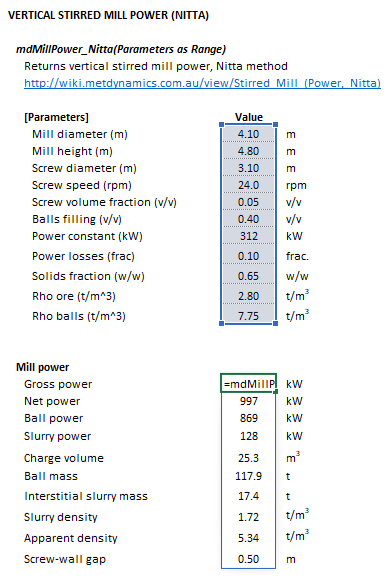Stirred Mill (Power, Nitta): Difference between revisions
Jump to navigation
Jump to search
md>Scott.Munro m (Text replacement - "\rho_{p}" to "\rho_{\rm p}") |
imported>Scott.Munro m (→Model theory) |
||
| (3 intermediate revisions by 2 users not shown) | |||
| Line 5: | Line 5: | ||
== Model theory == | == Model theory == | ||
{{Restricted content}} | |||
<hide> | |||
The Nitta approach computes mill power as: | The Nitta approach computes mill power as: | ||
| Line 45: | Line 48: | ||
where <math>f_{\rm s}</math> is the mass fraction of solids in the slurry (w/w), and <math>\rho_{\rm m}</math> is the densityy of solid ore particles (t/m<sup>3</sup>). | where <math>f_{\rm s}</math> is the mass fraction of solids in the slurry (w/w), and <math>\rho_{\rm m}</math> is the densityy of solid ore particles (t/m<sup>3</sup>). | ||
== Additional notes == | </hide><div class="user-show"> | ||
=== Additional notes === | |||
</div><hide> | |||
The Nitta model does not include a term for charge density, which may compromise its ability to predict mill power draw with alternative grinding media materials, ore densities or feed solids fractions. | The Nitta model does not include a term for charge density, which may compromise its ability to predict mill power draw with alternative grinding media materials, ore densities or feed solids fractions. | ||
</hide> | |||
== Excel == | == Excel == | ||
| Line 199: | Line 205: | ||
== See also == | == See also == | ||
* [[Mill (Herbst-Fuerstenau)]] | * [[Mill (Herbst-Fuerstenau)]] | ||
* [[ | * [[Stirred Mill (Perfect Mixing)]] | ||
* [[ | * [[Stirred Mill (Perfect Mixing, Dynamic)]] | ||
== References == | == References == | ||
Latest revision as of 07:11, 1 May 2025
Description
This article describes the Nitta method for estimating the power draw of a vertical stirred mill.[1]
Model theory
Additional notes
Excel
The Nitta mill power model may be invoked from the Excel formula bar with the following function call:
=mdMillPower_Nitta(Parameters as Range)
Invoking the function with no arguments will print Help text associated with the model, including a link to this page.
The Parameters array and model results are defined below in matrix notation, along with an example image showing the selection of the same arrays in the Excel interface:
|
|
SysCAD
The Nitta power model is an optional calculation for stirred mill units. If selected, the input and display parameters below are shown.
See also
References
- ↑ Nitta, S., Furuyama, T., Bissombolo, A. and Mori, S., 2006, September. Estimation of the motor power of the tower mill through dimensional analysis. In Proceedings of 23rd International Mineral Processing Congress (pp. 3-8).





